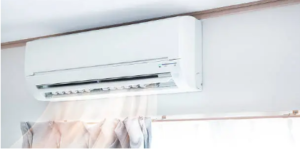In the relentless pursuit of sustainable living, the demand for energy-efficient solutions has never been more critical. As global temperatures continue to rise and climate change becomes an undeniable reality, finding eco-friendly alternatives in our daily lives is paramount. One such technological marvel that stands at the forefront of energy efficiency is the energy efficient reverse cycle ducted air conditioners. In this article, we delve into the world of these cutting-edge appliances, exploring their mechanisms, benefits, and their significant role in fostering a more sustainable future.
Understanding Reverse Cycle Ducted Air Conditioners
 Reverse cycle ducted air conditioners, often referred to as “heat pumps,” are multifunctional systems that provide both cooling and heating for residential and commercial spaces. Unlike traditional air conditioners that operate solely for cooling purposes, reverse cycle ducted air conditioners can reverse the refrigeration cycle, extracting heat from the outside air and transferring it indoors during colder seasons.
Reverse cycle ducted air conditioners, often referred to as “heat pumps,” are multifunctional systems that provide both cooling and heating for residential and commercial spaces. Unlike traditional air conditioners that operate solely for cooling purposes, reverse cycle ducted air conditioners can reverse the refrigeration cycle, extracting heat from the outside air and transferring it indoors during colder seasons.
How They Work
The core principle behind reverse cycle ducted air conditioners involves the use of refrigerant to absorb and release heat. During the cooling mode, the system extracts heat from the indoor air and releases it outside. Conversely, in heating mode, the refrigerant absorbs heat from the outdoor air and transfers it inside.
Energy Efficiency Features
- Inverter Technology: Reverse cycle ducted air conditioners equipped with inverter technology play a pivotal role in optimising energy consumption. Unlike traditional systems that operate at a fixed speed, inverter technology adjusts the compressor speed based on the heating or cooling requirements. It results in a more consistent and energy-efficient operation, reducing power consumption and minimising energy wastage.
- Zone Control: One of the standout features of energy efficient reverse cycle ducted air conditioners is their ability to incorporate zone control. It allows users to divide their living or working spaces into different zones, each with its own temperature control. By heating or cooling only the required zones, users can significantly reduce energy usage, contributing to both cost savings and environmental preservation.
- Smart Thermostats: Integrating smart thermostats with reverse cycle ducted air conditioners adds another layer of energy efficiency. These devices enable users to program and control the system remotely, optimising temperature settings based on occupancy patterns. Some models even incorporate machine learning algorithms that adapt to users’ preferences over time, further enhancing energy efficiency.
Benefits of Reverse Cycle Ducted Air Conditioners
- Year-Round Comfort: The ability to provide both cooling and heating makes reverse cycle ducted air conditioners a versatile and efficient solution for year-round comfort. Users no longer need separate systems for summer and winter, streamlining their HVAC requirements.
- Energy Cost Savings: The energy-efficient features of reverse cycle ducted air conditioners translate into tangible cost savings for users. The precise temperature control, inverter technology, and zone control functionalities all contribute to minimising energy consumption, resulting in lower electricity bills.
- Reduced Environmental Impact: By relying on the heat exchange process and utilising renewable energy sources, reverse cycle ducted air conditioners contribute to reducing greenhouse gas emissions. It aligns with the growing global emphasis on environmentally friendly practices and sustainable living.
- Quiet Operation: Many reverse cycle ducted air conditioners are designed with noise reduction features, ensuring a quieter operation compared to traditional HVAC systems. It not only enhances the comfort of indoor spaces but also contributes to a more peaceful and enjoyable environment.
As we stand at the intersection of technological advancement and environmental consciousness, energy efficient reverse cycle ducted air conditioners emerge as a beacon of energy efficiency in the realm of HVAC solutions. Their multifunctional capabilities, coupled with innovative features such as inverter technology, zone control, and smart thermostats, make them a compelling choice for those seeking sustainable comfort.
In the face of climate change, where every individual’s choices matter, adopting energy-efficient technologies like reverse cycle ducted air conditioners becomes a collective responsibility. The transition to these eco-friendly systems not only ensures personal comfort but also fosters a greener and more sustainable future for generations to come.